Data governance is crucial for the digital transformation of organisations. It is developed through various axes within the organisation, forming an integral part of the organisational digital transformation plan. In a world where organisations need to constantly reinvent themselves and look for new business models and opportunities to innovate, data governance becomes a key part of moving towards a fairer and more inclusive digital economy, while remaining competitive.
Organisations need to maximise the value of their data, identify new challenges and manage the role of data in the use and development of disruptive technologies such as Artificial Intelligence. Thanks to data governance, it is possible to make informed decisions, improve operational efficiency and ensure regulatory compliance, while ensuring data security and privacy.
To achieve this, it is essential to carry out a planned digital transformation, centred on a strategic data governance plan that complements the organisation's strategic plan. The UNE 0085 guide helps to implement data governance in any organisation and does so by placing special emphasis on the design of the programme through an evaluation cycle based on gap analysis, which must be relevant and decisive for senior management to approve the launch of the programme.
The data governance office, key body of the programme
A data governance programme should identify what data is critical to the organisation, where it resides and how it is used.. This must be accompanied by a management system that coordinates the deployment of data governance, management and quality processes. An integrated approach with other management systems that the organisation may have, such as the business continuity management system or the information security system, is necessary.
The Data Governance Office is the area in charge of coordinating the development of the different components of the data governance and management system, i.e. it is the area that participates in the creation of the guidelines, rules and policies that allow the appropriate treatment of data, as well as ensuring compliance with the different regulations.
The Data Governance Office should be a key body of the programme. It serves as a bridge between business areas, coordinating data owners and data stewards at the organisational level.
UNE 0085: guidelines for implementing data governance
Implementing a data governance programme is not an easy task. To help organisations with this challenge, the new UNE 0085 has been developed, which follows a process approach as opposed to an artefact approach and summarises as a guide the steps to follow to implement such a programme, thus complementing the family of UNE standards on data governance, management and quality 0077, 0078, 0079 and 0080.
This guide:
- It emphasises the importance of the programme being born aligned with the strategic objectives of the organisation, with strong sponsorship.
- Describes at a high level the key aspects that should be covered by the programme.
- Detalla diferentes escenarios tipo, que pueden ayudar a una organización a clarificar por dónde empezar y qué iniciativas debería priorizar, el modelo operativo y roles que necesitará para el despliegue.
- It presents the design of the data governance programme through an evaluation cycle based on gap analysis. It starts with an initial assessment phase (As Is) to show the starting situation of the organisation followed by a second phase in which the scope and objectives of the programme are defined and aligned with the strategic objectives of the organisation phase (To be), to carry out the gap analysis phase. It ends with a business case that includes deliverables such as scope, frameworks, programme objectives and milestones, budget, roadmap and measurable benefits with associated KPIs among other aspects. This use case will serve as the launch of the data governance programme by management and thus its implementation throughout the organisation. The different phases of the cycle in relation to the UNE 0077 data governance system are presented below:
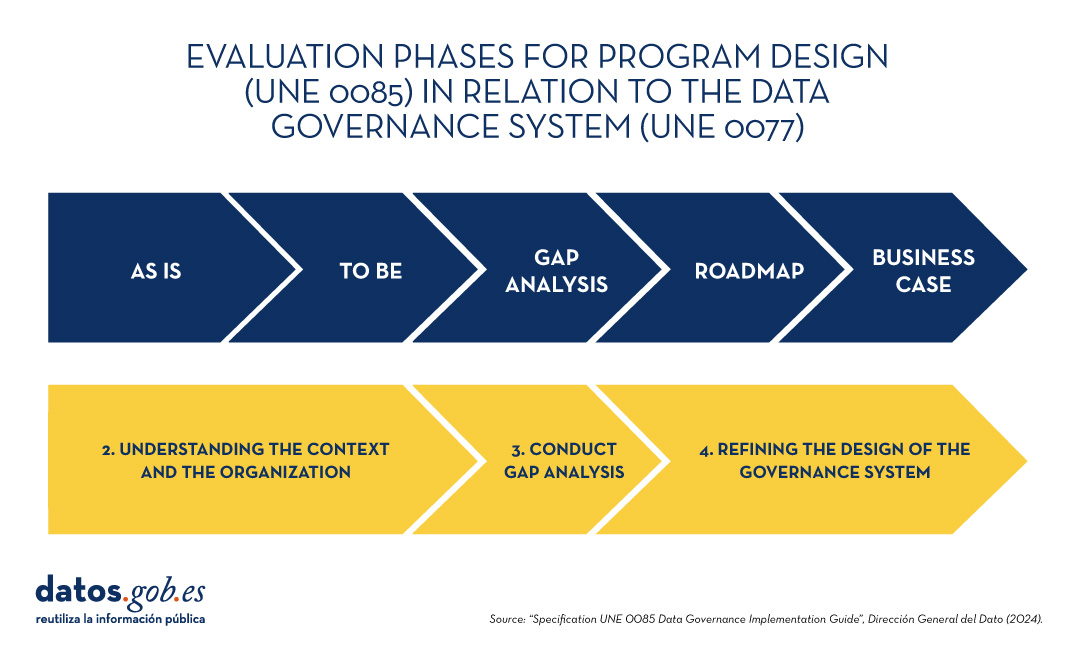
Finally, beyond processes and systems, we cannot forget people and the roles they play in this digital transformation. Data controllers and the entities involved are central to this organisational culture change. It is necessary to manage this change effectively in order to deploy a data governance operating model that fits the needs of each organisation.
It may seem complex to orchestrate and define an exercise of this magnitude, especially with abstract concepts related to data governance. This is where the new data governance office, which each organisation must establish, comes into play. This office will assist in these essential tasks, always following the appropriate frameworks and standards.
It is recommended to follow a methodology that facilitates this work, such as the UNE specifications for data governance, management and quality (0077, 0078, 0079 and 0080). These specifications are now complemented by the new UNE 0085, a practical implementation guide that can be downloaded free of charge from the AENOR website.
The content of this guide can be downloaded freely and free of charge from the AENOR portal through the link below by accessing the purchase section. Access to this family of UNE data specifications is sponsored by the Secretary of State for Digitalization and Artificial Intelligence, Directorate General for Data. Although the download requires prior registration, a 100% discount on the total price is applied at the time of finalizing the purchase. After finalizing the purchase, the selected standard or standards can be accessed from the customer area in “my products” section.
As tradition dictates, the end of the year is a good time to reflect on our goals and objectives for the new phase that begins after the chimes. In data, the start of a new year also provides opportunities to chart an interoperable and digital future that will enable the development of a robust data economy robust data economy, a scenario that benefits researchers, public administrations and private companies alike, as well as having a positive impact on the citizen as the end customer of many data-driven operations, optimising and reducing processing times. To this end, there is the European Data Strategy strategy, which aims to unlock the potential of data through, among others, the Data Act (Data Act), which contains a set of measures related to fair access to and use of data fair access to and use of data ensuring also that the data handled is of high quality, properly secured, etc.
As a solution to this need, in the last year the uNE data specifications which are normative and informative resources for implementing common data governance, management and quality processes. These specifications, supported by the Data Officethese specifications, supported by the Data Office, establish standards for well-governed data (UNE 0077), managed (UNE 0078) and with adequate levels of quality (UNE 0079), thus allowing for sustainable growth in the organisation during the implementation of the different processes. In addition to these three specifications, the UNE 0080 specification defines a maturity assessment guide and process to measure the degree of implementation of data governance, management and quality processes. For its part, the UNE 0081 also establishes a process of evaluation of the data asset itself, i.e. of the data sets, regardless of their nature or typology; in short, its content is closely related to UNE 0079 because it sets out data quality characteristics. Adopting all of them can provide multiple benefits. In this post, we look at what they are and what the process would be like for each specification.
So, with an eye to the future, we set a New Year's resolution: the application of the UNE data specifications to an organisation.
What are the benefits of your application and how can I access them?
In today's era, where data governance and efficient data management have become a fundamental pillar of organisational success, the implementation of the uNE data specifications specifications emerge as a guiding light towards excellence, leading the way forward. These specifications describe rigorous standardised processes that offer organisations the possibility to build a robust and reliable structure for the management of their data and information throughout its lifecycle.
By adopting the UNE specifications, you not only ensure data quality and security, but also provide a solid and adequate basis for informed decision-making by enriching organisational processes with good data practices. Therefore, any organisation that chooses to embrace these regulations in the new year will be moving closer to innovation, efficiency and trust in data governance and management; as well as preparing to meet the challenges and opportunities that the digital future holds digital future. The application of UNE specifications is not only a commitment to quality, but a strategic investment that paves the way for sustainable success in an increasingly competitive and dynamic business environment because:
- Maximising value contribution to business strategy
- Minimises risks in data processing
- Optimise tasks by avoiding unnecessary work
- It establishes homogeneous frameworks for reference and certification
- Facilitates information sharing with trust and sovereignty
The content of the guides can be downloaded free of charge from the AENOR portal via the links below. Registration is required for downloading. The discount on the total price is applied at the time of checkout.
- SPECIFICATION UNE 0077:2023
- SPECIFICATION UNE 0078:2023
- SPECIFICATION UNE 0079:2023
- SPECIFICATION UNE 0080:2023
- SPECIFICATION UNE 0081:2023
From datos.gob.es we have echoed the content of the same and we have prepared different didactic resources such as this infographic or this explanatory video.
How do they apply to an organisation?
Once the decision has been taken to address the implementation of these specifications, a crucial question arises: what is the most effective way to do this? The answer to this question will depend on the initial situation (marked by an initial maturity assessment), the type of organisation and the resources available at the time of establishing the master plan or implementation plan. Nevertheless, at datos.gob.es, we have published a series of contents prepared by experts in technologies linked to the data economy datos.gob.es, we have published a series of contents elaborated by experts in technologies linked to the data economy that will accompany you in the process.
Before starting, it is important to know the different processes that make up each of the UNE data specifications. This image shows what they are.
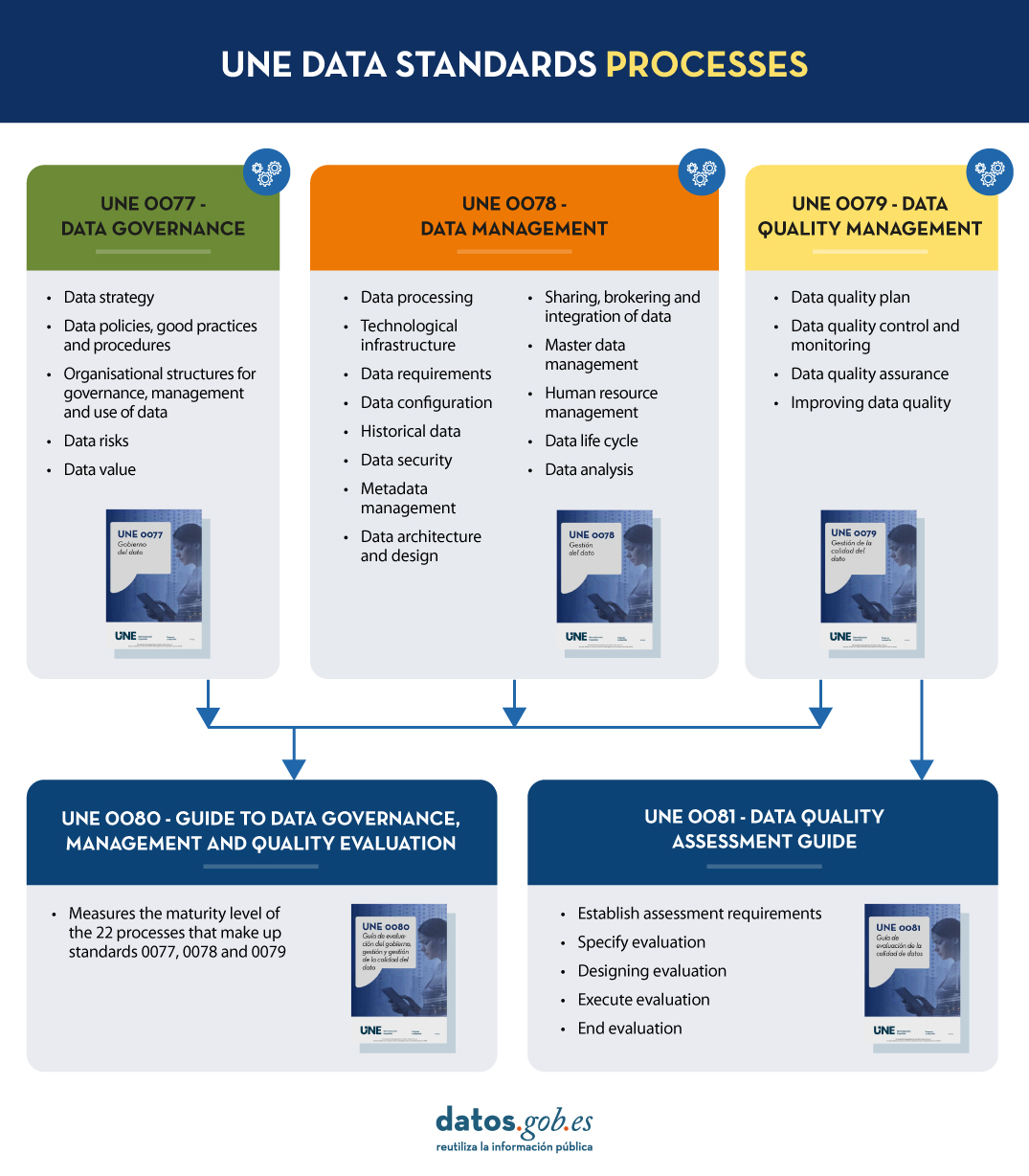
Once the basics are understood, the series of contents 'Application of the UNE data specifications' deals with a practical exercise, broken down into three posts, on a specific use case: the application of these specifications to open data. As an example, a need is defined for the fictitious Vistabella Town Council: to make progress in the open publication of information on public transport and cultural events.
- In the first post of the series, the importance of using the UNE 0077 data using the UNE 0077 Data Governance Specification to establish approved mechanisms to support the openness and publication of open data. Through this first content, an overview of the processes necessary to align the organisational strategy in such a way as to achieve maximum transparency and quality of public services through the reuse of information is provided.
- The second article in the series takes a closer look at the uNE 0079 data quality management standard and its application in the context of open data and its application in the context of open data. This content underlines that the quality of open data goes beyond the FAIR principles fAIR principles principles and stresses the importance of assessing quality using objective criteria. Through the practical exercise, we explore how Vistabella Town Council approaches the UNE processes to improve the quality of open data as part of its strategy to enhance the publication of data on public transport and cultural events.
- Finally, the uNE 0078 standard on data management is explained in a third article presenting the Data Sharing, Intermediation and Integration (CIIDat) process for the publication of open data, combined with specific templates.
Together, these three articles provide a guide for any organisation to move successfully towards open publication of key information, ensuring consistency and quality of data. By following these steps, organisations will be prepared to comply with regulatory standards with all the benefits that this entails.
Finally, embracing the New Year's resolution to implement the UNE data specifications represents a strategic and visionary commitment for any organisation, which will also be aligned with the European Data Strategy and the European roadmap that aims to shape a world-leading digital future.
The new UNE 0081 Data Quality Assessment specification, focused on data as a product (datasets or databases), complements the UNE 0079 Data Quality Management specification, which we analyse in this article, and focuses on data quality management processes. Both standards 0079 and 0081 complement each other and address data quality holistically:
- The UNE 0079 standard refers to the processes, the activities that the organisation must carry out to guarantee the appropriate levels of quality of its data to satisfy the strategy that the organisation has set itself.
- On the other hand, UNE 0081 defines a data quality model, based on ISO/IEC 25012 and ISO/IEC 25024, which details the quality characteristics that data can have, as well as some applicable metrics. It also defines the process to be followed to assess the quality of a particular dataset, based on ISO/IEC 25040. Finally, the specification details how to interpret the results obtained from the evaluation, showing concrete examples of application.
How can an organisation make use of this specification to assess the quality level of its data?
To answer this question, we will use the example of the Vistabella Town Council, previously used in previous articles. The municipality has a number of data sets, the quality of which it wants to evaluate in order to improve them and provide a better service to citizens. The institution is aware that it works with many types of data (transactional, master, reference, etc.), so the first thing it does is to first identify the data sets that provide value and for which not having adequate levels of quality may have repercussions on the day-to-day work. Some criteria to follow when selecting these sets can be: data that provide value to the citizen, data resulting from a data integration process or master view of the data, critical data because they are used in several processes/procedures, etc.
The next step will be to determine at which point(s) in the lifecycle of the municipality's operational processes these data quality checks will be performed.
This is where the UNE 0081 specification comes into play. The evaluation is done on the basis of the "business rules" that define the requirements, data requirements or validations that the data must meet in order to provide value to the organisation. Some examples are shown below:
- Citizens' ID cards will have to comply with the specific syntax for this purpose (8 numbers and one letter).
- Any existing date in the system shall follow the notation DD-MM-YYYYYY.
- Records of documentation dated after the current date will not be accepted.
- Traceability of who has made a change to a dataset and when.
In order to systematically and comprehensively identify the business rules that data has to comply with at each stage of its lifecycle, the municipality uses a methodology based on BR4DQ.
The municipality then reviews all the data quality characteristics included in the specification, prioritises them, and determines a first set of data quality characteristics to be taken into account for the evaluation. For this purpose, and in this first stage, the municipality decided to stick exclusively to the 5 inherent characteristics of ISO 25012 defined within the specification. These are: accuracy, completeness, consistency, credibility and timeliness.
Similarly, for each of these first characteristics that have been agreed to be addressed, possible properties are identified. To this end, the municipality finally decided to work with the following quality model, which includes the following characteristics and properties:
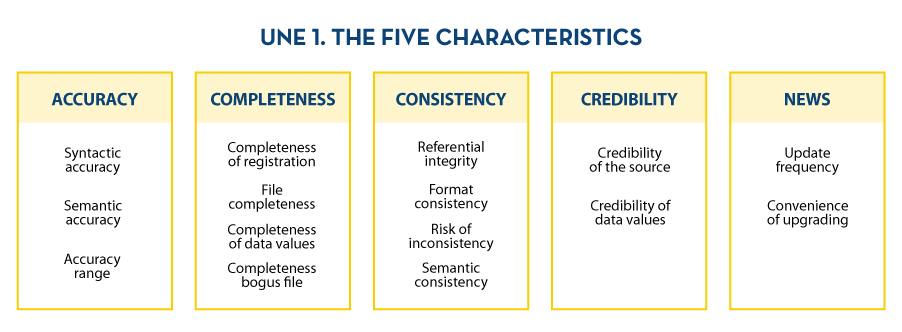
At this point, the municipality has identified the dataset to be assessed, as well as the business rules that apply to it, and which aspects of quality it will focus on (data quality model). Next, it is necessary to carry out data quality measurement through the validation of business rules. Values for the different metrics are obtained and computed in a bottom-up approach to determine the level of data quality of the repository
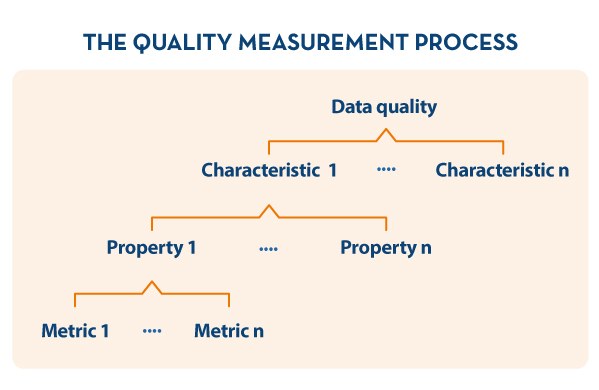
Definition of the evaluation process
In order to carry out the assessment in an appropriate way, it is decided to make use of the quality assessment process based on ISO 25024, indicated in the UNE 0081 specification (see below).
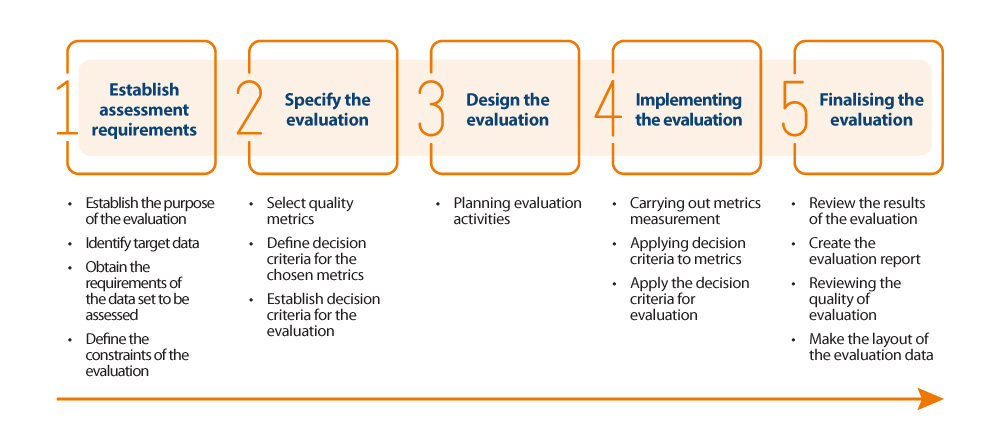
Implementation of the evaluation process
The following is a summary of the most noteworthy aspects carried out by the City Council during stage 4 of the evaluation process:
- Validation of the degree of compliance with each business rule by property: Having all the business rules classified by property, the degree of compliance with each of them is validated, thus obtaining a series of values for each of the metrics. This is run on each of the data sets to be evaluated.
As an example, for the syntactic accuracy property, two metrics are obtained:
- Number of records that comply with the syntactic correctness business rules: 826254
- Number of records that must comply with the syntactic correctness business rules: 850639
- Quantification of the value of the property: From these metrics, the value of the property is quantified and determined using the measurement function specified in the UNE 0081 specification. For the specific case of syntactic accuracy, it is determined that a record density of 97.1% complies with all syntactic accuracy rules.
- Calculation of the characteristic value: This is done by making use of the results of each of the data quality metrics associated with a property. To calculate it, and as specified in the UNE 0081 specification, it is decided to follow a weighted sum in which each property has the same weight. In the case of Accuracy, Syntactic Accuracy values are available: 97.1, Semantic accuracy: 95, and Accuracy range: 92.9. Computing these 3 scores, a value of 95 out of 100 was obtained for this characteristic.
- Shift from quantitative to qualitative value: In order to provide a final quality result, it is decided to use another weighted sum; in this case, all dimensions have the same weight. Based on the above aggregated results of the above characteristics: Accuracy: 95, Completeness: 87, Consistency: 90, Credibility: 88, News: 93, a quality level of 90 out of 100 is determined for the repository. Finally, it is necessary to move from this quantitative value of 0 to 100 to a qualitative value. In this particular example, using the percentage-based quality level function, it is concluded that the quality level of the repository, for the analysed property, is 4, or "Very Good".
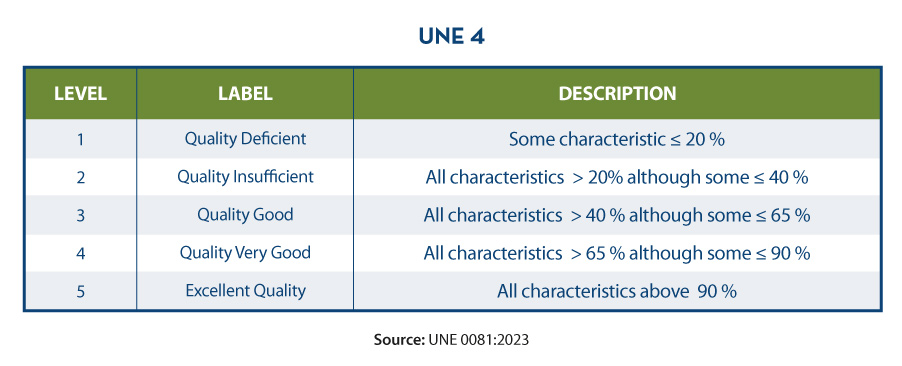
Results visualisation
Finally, once the evaluation of all the characteristics has been carried out, the municipality builds a series of data quality control dashboards with different levels of aggregation (characteristic, property, dataset and table/view) based on the results of the evaluation, so that the level of quality can be quickly consulted. For this purpose, results at different levels of aggregation are shown as an example.
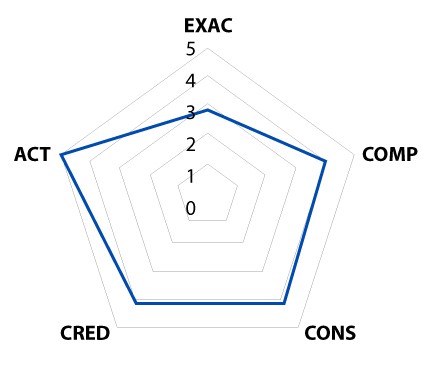
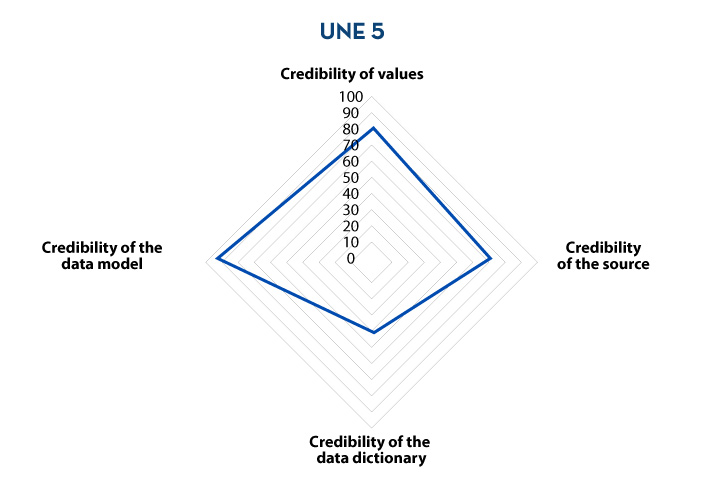
As can be seen throughout the application example, there is a direct relationship between the application of this UNE 0081 specification, with certain parts of the 0078 specification, specifically with the data requirements management process, and with the UNE 0079specification, at least with the data planning and quality control processes. As a result of the evaluation, recommendations for quality improvement (corrective actions) will be established, which will have a direct impact on the established data processes, all in accordance with Deming's PDCA continuous improvement circle.
Once the example has been completed, and as an added value, it should be noted that it is possible to certify the level of data quality of organisational repositories. This will require a certification body to provide this data quality service, as well as an ISO 17025 accredited laboratory with the power to issue data quality assessment reports.
The content of this guide can be downloaded freely and free of charge from the AENOR portal through the link below by accessing the purchase section. Access to this family of UNE data specifications is sponsored by the Secretary of State for Digitalization and Artificial Intelligence, Directorate General for Data. Although the download requires prior registration, a 100% discount on the total price is applied at the time of finalizing the purchase. After finalizing the purchase, the selected standard or standards can be accessed from the customer area in “my products” section.
Content prepared by Dr. Fernando Gualo, Professor at UCLM and Data Governance and Quality Consultant.The content and the point of view reflected in this publication are the sole responsibility of its author.
We live in a constantly evolving environment in which data is growing exponentially and is also a fundamental component of the digital economy. In this context, it is necessary to unlock its potential to maximize its value by creating opportunities for its reuse. However, it is important to bear in mind that this increase in speed, scale and variety of data means that ensuring its quality is more complicated.
In this scenario, the need arises to establish common processes applicable to the data assets of all organizations throughout their lifecycle. All types of institutions must have well-governed, well-managed data with adequate levels of quality, and a common evaluation methodology is needed that can help to continuously improve these processes and allow the maturity of an organization to be evaluated in a standardized way.
The Data Office has sponsored, promoted and participated in the generation of the UNE specifications, normative resources that allow the implementation of common processes in data management and that also provide a reference framework to establish an organizational data culture.
On the one hand, we find the specifications UNE 0077:2023 Data Governance, UNE 0078:2023 Data Management and UNE 0079:2023 Data Quality Management, which are designed to be applied jointly, enabling a solid reference framework that encourages the adoption of sustainable and effective practices around data.
In addition, a common assessment methodology is needed to enable continuous improvement of data governance, management and data quality management processes, as well as the measurement of the maturity of organizations in a standardized way. The UNE 0080 specification has been developed for the development of a homogeneous framework for the evaluation of an organization's treatment of data.
With the aim of offering a process based on international standards that helps organizations to use a quality model and to define appropriate quality characteristics and metrics, the UNE 0081 Data Quality Assessment specification has been generated, which complements the UNE 0079 Data Quality Management.
The following infographic summarizes the key points of the UNE Specifications on data and the main advantages of their application (click on the image to access the infographic).
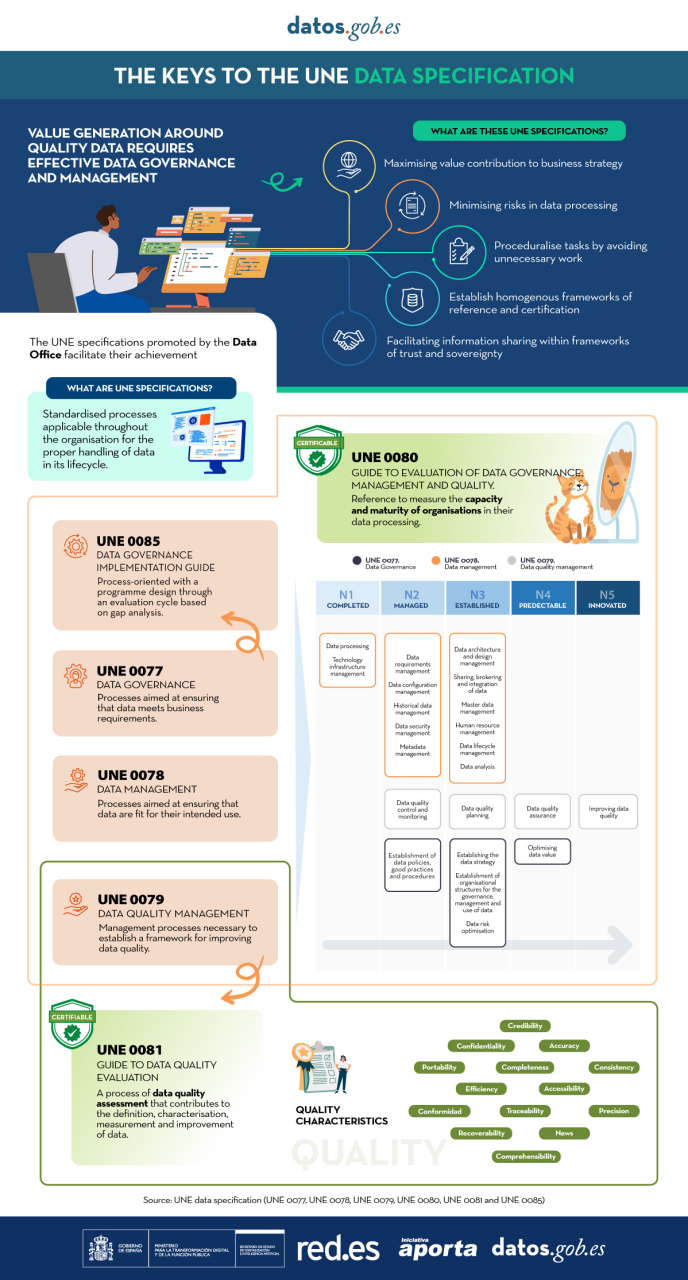
Today, data quality plays a key role in today's world, where information is a valuable asset. Ensuring that data is accurate, complete and reliable has become essential to the success of organisations, and guarantees the success of informed decision making.
Data quality has a direct impact not only on the exchange and use within each organisation, but also on the sharing of data between different entities, being a key variable in the success of the new paradigm of data spaces. When data is of high quality, it creates an environment conducive to the exchange of accurate and consistent information, enabling organisations to collaborate more effectively, fostering innovation and the joint development of solutions.
Good data quality facilitates the reuse of information in different contexts, generating value beyond the system that creates it. High-quality data are more reliable and accessible, and can be used by multiple systems and applications, which increases their value and usefulness. By significantly reducing the need for constant corrections and adjustments, time and resources are saved, allowing for greater efficiency in the implementation of projects and the creation of new products and services.
Data quality also plays a key role in the advancement of artificial intelligence and machine learning. AI models rely on large volumes of data to produce accurate and reliable results. If the data used is contaminated or of poor quality, the results of AI algorithms will be unreliable or even erroneous. Ensuring data quality is therefore essential to maximise the performance of AI applications, reduce or eliminate biases and realise their full potential.
With the aim of offering a process based on international standards that can help organisations to use a quality model and to define appropriate quality characteristics and metrics, the Data Office has sponsored, promoted and participated in the generation of the specification UNE 0081 Data Quality Assessment that complements the already existing specification UNE 0079 Data Quality Management, focused more on the definition of data quality management processes than on data quality as such.
UNE Specification - Guide to Data Quality Assessment
The UNE 0081 specification, a family of international standards ISO/IEC 25000, makes it possible to know and evaluate the quality of the data of any organisation, making it possible to establish a future plan for its improvement, and even to formally certify its quality. The target audience for this specification, applicable to any type of organisation regardless of size or dedication, will be data quality officers, as well as consultants and auditors who need to carry out an assessment of data sets as part of their functions.
The specification first sets out the data quality model, detailing the quality characteristics that data can have, as well as some applicable metrics, and once this framework is defined, goes on to define the process to be followed to assess the quality of a dataset. Finally, the specification ends by detailing how to interpret the results obtained from the evaluation by showing some concrete examples of application.
Data quality model
The guide proposes a series of quality characteristics following those present in the ISO/IEC 25012 standard , classifying them between those inherent to the data, those dependent on the system where the data is hosted, or those dependent on both circumstances. The choice of these characteristics is justified as they encompass those present in other frameworks such as DAMA, FAIR, EHDS, IA Act and GDPR.
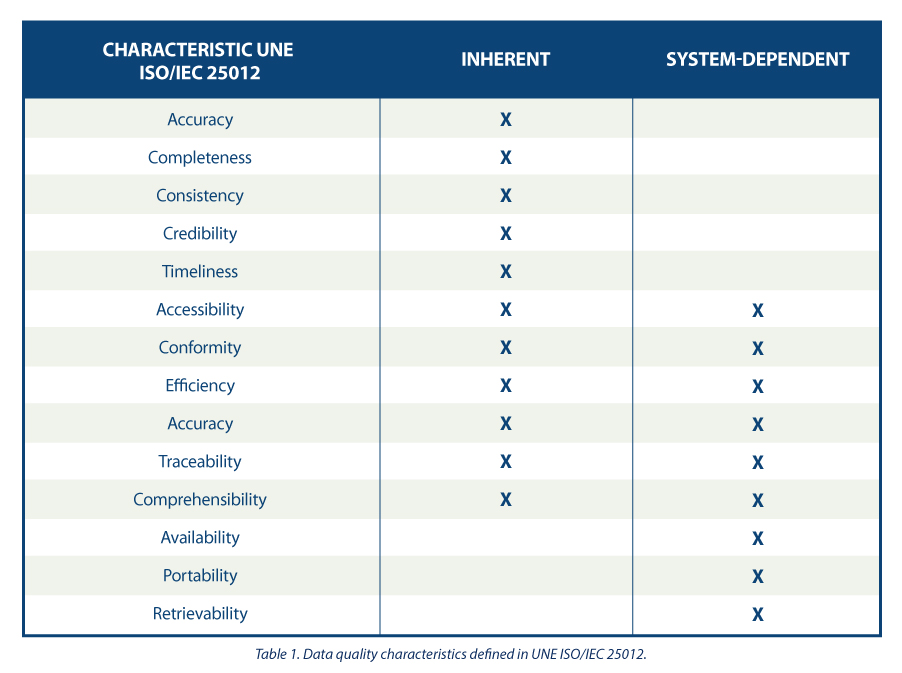
Based on the defined characteristics, the guide uses ISO/IEC 25024 to propose a set of metrics to measure the properties of the characteristics, understanding these properties as "sub-characteristics" of the characteristics.
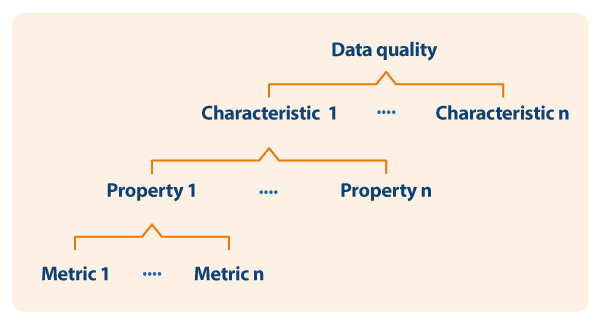
Thus, as an example, following the dependency scheme, for the specific characteristic of "consistency of data format" its properties and metrics are shown, one of them being detailed


Process for assessing the quality of a data set
For the actual assessment of data quality, the guide proposes to follow the ISO/IEC 25040 standard, which establishes an assessment model that takes into account both the requirements and constraints defined by the organisation, as well as the necessary resources, both material and human. With these requirements, an evaluation plan is established through specific metrics and decision criteria based on business requirements, which allows the correct measurement of properties and characteristics and interpretation of the results.
Below is an outline of the steps in the process and its main activities:
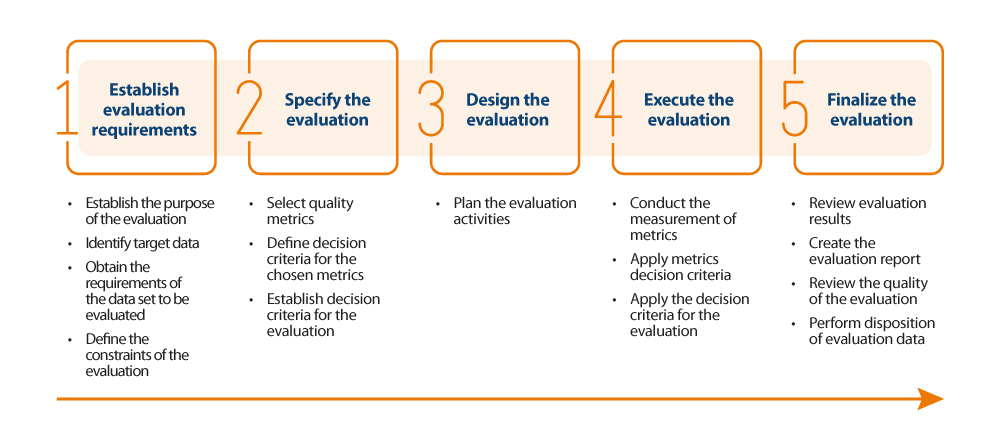
Results of the quality assesment
The outcome of the assessment will depend directly on the requirements set by the organisation and the criteria for compliance. The properties of the characteristics are usually evaluated from 0 to 100 based on the values obtained in the metrics defined for each of them, and the characteristics in turn are evaluated by aggregating the previous ones also from 0 to 100 or by converting them to a discrete value from 1 to 5 (1 poor quality, 5 excellent quality) depending on the calculation and weighting rules that have been established. In the same way that the measurement of the properties is used to obtain the measurement of their characteristics, the same happens with these characteristics, which by means of their weighted sum based on the rules that have been defined (being able to establish more weight to some characteristics than to others), a final result of the quality of the data can be obtained. For example, if we want to calculate the quality of data based on a weighted sum of their intrinsic characteristics, where, because of the type of business, we are interested in giving more weight to accuracy, then we could define a formula such as the following:
Data quality = 0.4*Accuracy + 0.15*Completeness + 0.15*Consistency + 0.15*Credibility + 0.15*Currentness
Assume that each of the quality characteristics has been similarly calculated on the basis of the weighted sum of their properties, resulting in the following values: Accuracy=50%, Completeness=45%, Consistency=35%, Credibility=100% and Currency=50%. This would result in data quality:
Data quality = 0.4*50% + 0.15*45% + 0.15*35% + 0.15*100% + 0.15*50% = 54.5%
Assuming that the organisation has established requirements as shown in the following table:

It could be concluded that the organisation as a whole has a data score of "3= Good Quality".
In summary, the assessment and improvement of the quality of the dataset may be as thorough and rigorous as necessary, and should be carried out in an iterative and constant manner so that the data is continuously increasing in quality, so that a minimum data quality is ensured or can even be certified. This minimum data quality can refer to improving data sets internal to an organisation, i.e. those that the organisation manages and exploits for the operation of its business processes; or it can be used to support the sharing of data sets through the new paradigm of data spaces generating new market opportunities. In the latter case, when an organisation wants to integrate its data into a data space for future brokering, it is desirable to carry out a quality assessment, labelling the dataset appropriately with reference to its quality (perhaps by metadata). Data of proven quality has a different utility and value than data that lacks it, positioning the former in a preferential position in the competitive market.
The content of this guide, as well as the rest of the UNE specifications mentioned, can be viewed freely and free of charge from the AENOR portal through the link below by accessing the purchase section and marking “read” in the dropdown where “pdf” is pre-selected. Access to this family of UNE data specifications is sponsored by the Secretary of State for Digitalization and Artificial Intelligence, Directorate General for Data. Although viewing requires prior registration, a 100% discount on the total price is applied at the time of finalizing the purchase. After finalizing the purchase, the selected standard or standards can be accessed from the customer area in the my products section.
https://tienda.aenor.com/norma-une-especificacion-une-0080-2023-n0071383
https://tienda.aenor.com/norma-une-especificacion-une-0079-2023-n0071118
https://tienda.aenor.com/norma-une-especificacion-une-0078-2023-n0071117
https://tienda.aenor.com/norma-une-especificacion-une-0077-2023-n0071116
The main motivation of this first article - of a series of three - is to explain how to use the UNE 0077 data governance specification (see Figure 1) to establish approved and validated mechanisms that provide organizational support for aspects related to data openness and publication for subsequent use by citizens and other organizations.
To understand the need and utility of data governance, it must be noted that, as a premise, every organization should start with an organizational strategy. To better illustrate the article, consider the example of the municipality of an imaginary town called Vistabella. Suppose the organizational strategy of the Vistabella City Council is to maximize the transparency and quality of public services by reusing public service information.
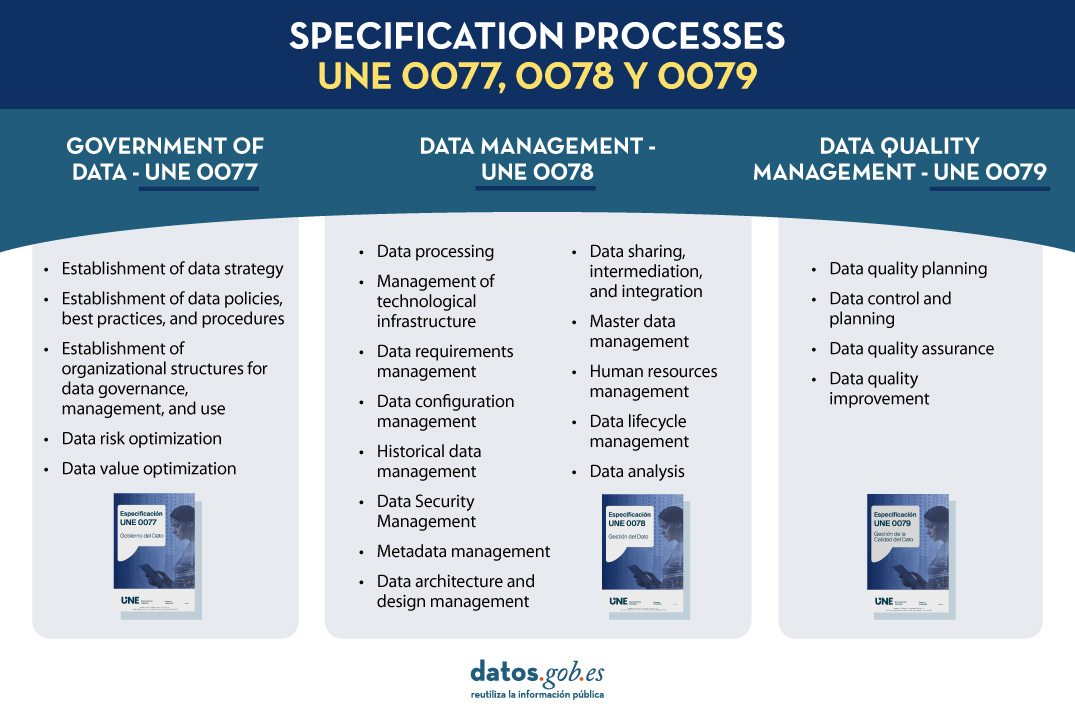
Fig. 1. Specification processes UNE 0077, 0078 and 0079
To support this organizational strategy, the Vistabella City Council needs a data strategy, the main objective of which is to promote the publication of open data on the respective open data portals and encourage their reuse to provide quality data to its residents transparently and responsibly. The Mayor of the Vistabella City Council must launch a data governance program to achieve this main objective. For this purpose, a working group composed of specialized data experts from the City Council is assigned to tackle this program. This group of experts is given the necessary authority, a budget, and a set of responsibilities.
When starting, these experts decide to follow the process approach proposed in UNE 0077, as it provides them with a suitable guide to carry out the necessary data governance actions, identifying the expected process outcomes for each of the processes and how these can be materialized into specific artifacts or work products.
This article explains how the experts have used the processes in the UNE 0077 specification to achieve their goal. Out of the five processes detailed in the specification, we will focus, by way of example, on only three of them: the one describing how to establish the data strategy, the one describing how to establish policies and best practices, and the one describing how to establish organizational structures.
Before we begin, it is important to remember the structure of the process descriptions in the different UNE specifications (UNE 0077, UNE 0078, and UNE 0079). All processes are described with a purpose, a list of expected process outcomes (i.e., what is expected to be achieved when the process is executed), a set of tasks that can be followed, and a set of artifacts or work products that are the manifestation of the process outcomes.
"Data Strategy Establishment Process"
The team of experts from the Vistabella City Council decided to follow each of the tasks proposed in UNE 0077 for this process. Below are some aspects of the execution of these tasks:
T1. Evaluate the capabilities, performance, and maturity of the City Council for the publication of open data. To do this, the working group gathered all possible information about the skills, competencies, and experiences in publishing open data that the Vistabella City Council already had. They also collected information about the downloads that have been made so far of published data, as well as a description of the data itself and the different formats in which it has been published. They also analyzed the City Council's environment to understand how open data is handled. The work product generated was an Evaluation Report on the organization's data capabilities, performance, and maturity.
T2. Develop and communicate the data strategy. Given its importance, to develop the data strategy, the working group used the Plan to promote the opening and reuse of open data as a reference to shape the data strategy stated earlier, which is to "promote the publication of open data on the respective open data portals and encourage their reuse to provide quality data to its residents transparently and responsibly." Additionally, it is important to note that data openness projects will be designed to eventually become part of the structural services of the Vistabella City Council. The work products generated will be the adapted Data Strategy itself and a specific communication plan for this strategy.
T3. Identify which data should be governed according to the data strategy. The Vistabella City Council has decided to publish more data about urban public transport and cultural events in the municipality, so these are the data that should be governed. This would include data of different types: statistical data, geospatial data, and some financial data. To do this, they propose using the Plan to promote the opening and reuse of open data again. The work product will be a list of the data that should be governed, and in this case, also published on the platform. Later on, the experts will be asked to reach an agreement on the meaning of the data and choose the most representative metadata to describe the different business, technical, and operational characteristics.
T4. Develop the portfolio of data programs and projects. To achieve the specific objective of the data strategy, a series of specific projects related to each other are identified, and their viability is determined. The work product generated through this task will be a portfolio of projects that covers these objectives:
- Planning, control, and improvement of the quality of open data
- Ensuring compliance with security standards
- Deployment of control mechanisms for data intermediation
- Management of the configuration of data published on the portal
T5. Monitor the degree of compliance with the data strategy. To do this, the working group defines a series of key performance indicators that are measured periodically to monitor key aspects related to the quality of open data, compliance with security standards, use of data intermediation mechanisms, and management of changes to the data published on the portal. The work product generated consists of periodic reports on the monitoring of the data strategy.
"Establishment of Data Policies, Best Practices, and Procedures Process"
The data strategy is implemented through a series of policies, best practices, and procedures. To determine these policies or procedures, you can follow the process of Establishing Data Policies, Best Practices, and Procedures detailed in UNE 0077. For each of the data identified in the previous process, it may be necessary to define specific policies for each area of action described in the established data strategy.
To have a systematic and consistent way of working and to avoid errors, the Vistabella City Council's working group decides to model and publish its own process for defining strategies based on the generic definition of that process contained in Specification UNE 0077, tailored to the specific characteristics of the Vistabella City Council.
This process could be followed by the working group as many times as necessary to define and approve data policies, best practices, and procedures.
In any case, it is important for the customization of this process to identify and select the principles, standards, ethical aspects, and relevant legislation related to open data. To do this, a framework is defined, consisting of a regulatory framework and a framework of standards.
The regulatory framework includes:
- The legal framework related to the reuse of public sector information.
- The General Data Protection Regulation (GDPR) to ensure that the minimum requirements for the security and privacy of information are met when publishing open data on the portal.
The framework of standards includes, among others:
- The practical guide for improving the quality of open data, which provides support to ensure that the shared data is of quality.
- The UNE specifications 0077, 0078, and 0079 themselves, which contain best practices for data governance, management, and quality.
This framework, along with the defined process, will be used by the working group to develop specific data policies that should be communicated through the appropriate publication, taking into account the most appropriate legal tools available. Some of these policies may be published, for example, as municipal resolutions or announcements, in compliance with the current regional or national legislation.
"Establishment of Organizational Structures for Data Governance, Management, and Use Process"
Even though the established Working Group is making initial efforts to address the strategy, it is necessary to create an organizational structure responsible for coordinating the necessary work related to the governance, management, and quality management of open data. For this purpose, the corresponding process detailed in UNE 0077 will be followed. Similar to the first section, the explanation is provided with the structure of the tasks to be developed:
T1. Define an organizational structure for data governance, management, and use. It is interesting to visualize the Vistabella City Council as a federated set of council offices and other municipal services that could share a common way of working, each with the necessary independence to define and publish their open data. Remember that initially, this data pertained to urban transport and cultural events. This involves identifying individual and collective roles, chains of responsibility, and accountability, as well as defining a way of communicating among them. The main product of this work will be an organizational structure to support various activities. These organizational structures must be compatible with the functional role structures that already exist in the City Council. In this regard, one can mention, by way of example, the information responsible unit, whose role is highlighted in Law 37/2007 as one of the most important roles. The information responsible unit primarily has the following four functions:
- Coordinate information reuse activities with existing policies regarding publications, administrative information, and electronic administration.
- Facilitate information about competent bodies within their scope for receiving, processing, and resolving reuse requests transmitted.
- Promote the provision of information in appropriate formats and keep it updated as much as possible.
- Coordinate and promote awareness, training, and promotional activities.
T2. Establish the necessary skills and knowledge. For each of the functions mentioned above of the information responsible units, it will be necessary to identify the skills and knowledge required to manage and publish the open data for which they are responsible. It is important to note that knowledge and skills should encompass both technical aspects in the field of open data publication and domain-specific knowledge related to the data being opened. All these knowledge and skills should be appropriately recognized and listed. Later on, a working group may be tasked with designing training plans to ensure that individuals involved in the information responsible units possess these knowledge and skills.
T3. Monitor the performance of organizational structures. In order to quantify the performance of organizational structures, it will be necessary to define and measure a series of indicators that allow modeling different aspects of the work of the people included in the organizational structures. This may include aspects such as the efficiency and effectiveness of their work or their problem-solving ability.
We have reached the end of this first article in which some aspects of how to use three of the five processes in the UNE 0077:2023 specification have been described to outline what open data governance should look like. This was done using an example of a City Council in an imaginary town called Vistabella, which is interested in publishing open data on urban transport and cultural events.
The content of this guide can be downloaded freely and free of charge from the AENOR portal through the link below by accessing the purchase section. Access to this family of UNE data specifications is sponsored by the Secretary of State for Digitalization and Artificial Intelligence, Directorate General for Data. Although the download requires prior registration, a 100% discount on the total price is applied at the time of finalizing the purchase. After finalizing the purchase, the selected standard or standards can be accessed from the customer area in the my products section.
https://tienda.aenor.com/norma-une-especificacion-une-0077-2023-n0071116
Content developed by Dr. Ismael Caballero, Associate Professor at UCLM, and Dr. Fernando Gualo, PhD in Computer Science, and Chief Executive Officer and Data Quality and Data Governance Consultant. The content and viewpoints reflected in this publication are the sole responsibility of the authors."
Motivation
According to the European Data Proposal Law, data is a fundamental component of the digital economy and an essential resource for ensuring ecological and digital transitions. In recent years, the volume of data generated by humans and machines has experienced an exponential increase. It is essential to unlock the potential of this data by creating opportunities for its reuse, removing obstacles to the development of the data economy, and respecting European norms and values. In line with the mission of reducing the digital divide, measures must be promoted that allow everyone to benefit from these opportunities fairly and equitably.
However, a downside of the high availability of data is that as more data accumulates, chaos ensues when it is not managed properly. The increase in volume, velocity, and variety of data also implies a greater difficulty in ensuring its quality. And in situations where data quality levels are inadequate, as analytical techniques used to process datasets become more sophisticated, individuals and communities can be affected in new and unexpected ways.
In this changing scenario, it is necessary to establish common processes applicable to data assets throughout an organization's lifecycle, maximizing their value through data governance initiatives that ensure a structured, managed, coherent, and standardized approach to all activities, operations, and services related to data. Ultimately, it must be ensured that the definition, creation, storage, maintenance, access, and use of data (data management) are done following a data strategy aligned with organizational strategies (data governance), and that the data used is suitable for the intended use (data quality).
UNE Specifications for Data Governance, Management, and Quality
The Data Office, a unit responsible for promoting the sharing, management, and use of data across all productive sectors of the Spanish economy and society, in response to the need for a reference framework that supports both public and private organizations in their efforts to ensure adequate data governance, management, and quality, has sponsored, promoted, and participated in the development of national UNE specifications in this regard.
The UNE 0077:2023 Data Governance, UNE 0078:2023 Data Management, and UNE 0079:2023 Data Quality Management specifications are designed to be applied jointly, enabling the creation of a solid and harmonized reference framework that promotes the adoption of sustainable and effective data practices.
Coordination is driven by data governance, which establishes the necessary mechanisms to ensure the proper use and exploitation of data through the implementation and execution of data management processes and data quality management processes, all in accordance with the needs of the relevant business process and taking into account the limitations and possibilities of the organizations that use the data.
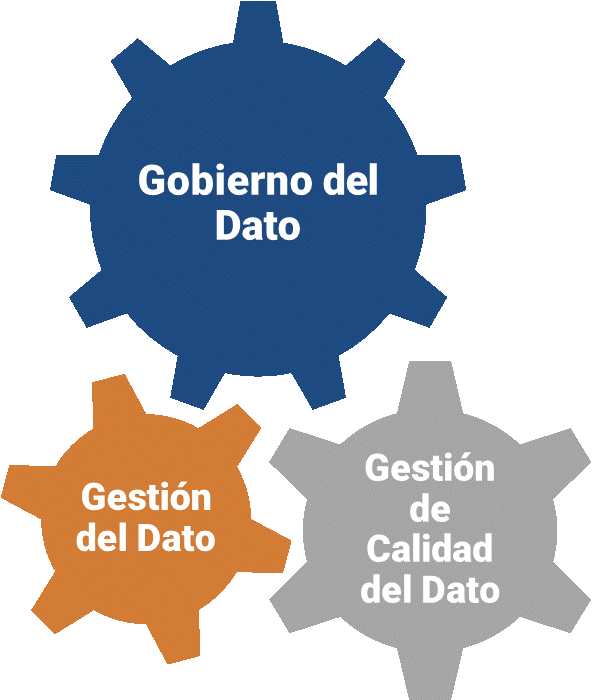
Each regulatory specification is presented with a process-oriented approach, and each of the presented processes is described in terms of its contribution to the seven components of a data governance and management system, as introduced in COBIT 2019:
- Process, detailing its purpose, outcome, tasks, and products according to ISO 8000-61.
- Principles, policies, and frameworks.
- Organizational structures, identifying the data governance bodies and decision-making structures.
- Information, required and generated in each process.
- Culture, ethics, and behavior, as a set of individual and collective behaviors of people and the organization.
- People, skills, and competencies needed to complete all activities and make decisions and corrective actions.
- Services, infrastructure, and applications that include technology-related aspects to support data management, data quality management, and data governance processes.
UNE 0077:2023 Specification_Data Governance
The UNE 0077:2023 specification covers aspects related to data governance. It describes the creation of a data governance framework to evaluate, direct, and monitor the use of an organization's data, so that it contributes to its overall performance by obtaining the maximum value from the data while mitigating risks associated with its use. Therefore, data governance has a strategic character, while data management has a more operational focus aimed at achieving the goals set in the strategy.
The implementation of proper data governance involves the correct execution of the following processes:
- Establishment of data strategy
- Establishment of data policies, best practices, and procedures
- Establishment of organizational structures
- Optimization of data risks
- Optimization of data value
UNE 0078:2023 Specification_Data Management
The UNE 0078:2023 specification covers the aspects related to data management. Data management is defined as the set of activities aimed at ensuring the successful delivery of relevant data with adequate levels of quality to the agents involved throughout the data life cycle, supporting the business processes established in the organizational strategy, following the guidelines of data governance, and in accordance with the principles of data quality management.
The implementation of adequate data management involves the development of thirteen processes:
- Data processing
- Management of the technological infrastructure
- Management of data requirements
- Management of data configuration
- Historical data management
- Data security management
- Metadata management
- Management of data architecture and design
- Data sharing, intermediation and integration
- Master data management
- Human resource management
- Data lifecycle management
- Data analysis
UNE 0079:2023 Specification_Data Quality Management
The UNE 0079:2023 specification covers the data quality management processes necessary to establish a framework for improving data quality. Data quality management is defined as the set of activities aimed at ensuring that data has adequate quality levels for use that allows an organization's strategy to be satisfied. Having quality data will allow an organization to achieve the maximum potential of data through its business processes.
According to Deming's continuous improvement PDCA cycle, data quality management involves four processes:
- Data quality planning,
- Data quality control and monitoring,
- Data quality assurance, and
- Data quality improvement.
The data quality management processes are intended to ensure that data meets the data quality requirements expressed in accordance with the ISO/IEC 25012 standard.
Maturity Model
As a joint application framework for the different specifications, a data maturity model is outlined that integrates the processes of governance, management, and data quality management, showing how the progressive implementation of processes and their capabilities can be carried out, defining a path of improvement and excellence across different levels to become a mature data organization.
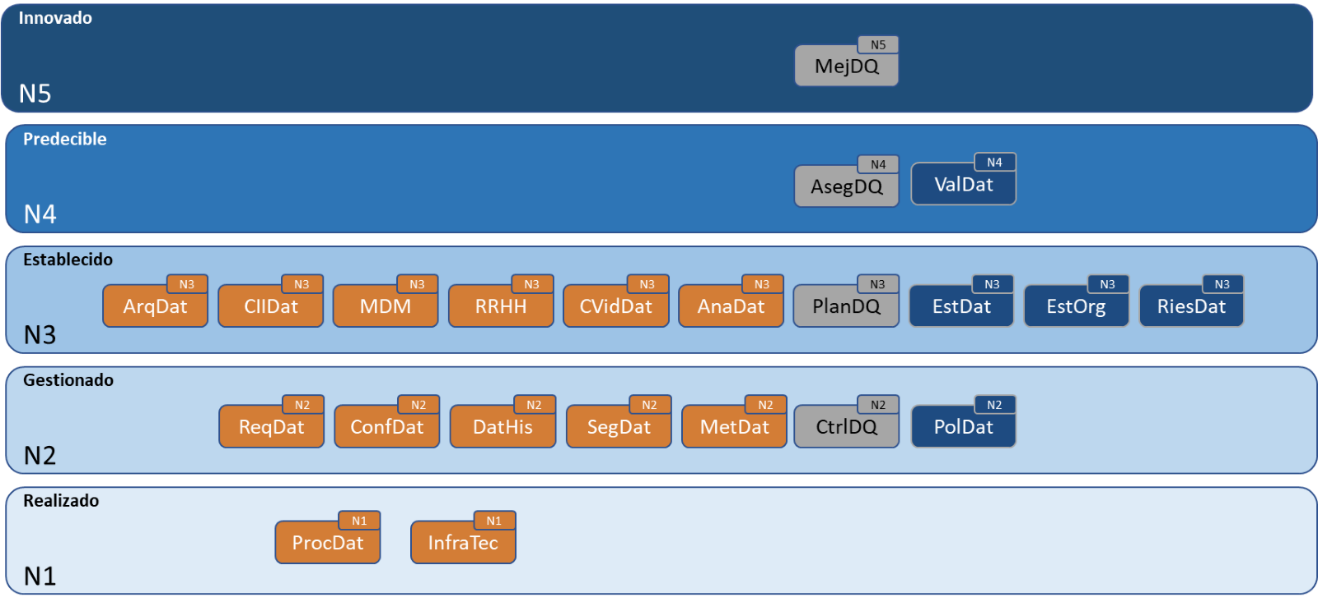
The Data Office will promote the development of the UNE 0080 specification to provide a data maturity assessment model that complies with the content of the governance, management, and data quality management specifications and the aforementioned framework.
The content of this guide, as well as the rest of the UNE specifications mentioned, can be viewed freely and free of charge from the AENOR portal through the link below by accessing the purchase section and marking “read” in the dropdown where “pdf” is pre-selected. Access to this family of UNE data specifications is sponsored by the Secretary of State for Digitalization and Artificial Intelligence, Directorate General for Data. Although viewing requires prior registration, a 100% discount on the total price is applied at the time of finalizing the purchase. After finalizing the purchase, the selected standard or standards can be accessed from the customer area in the my products section.
The content of this guide can be downloaded freely and free of charge from the AENOR portal through the link below by accessing the purchase section. Access to this family of UNE data specifications is sponsored by the Secretary of State for Digitalization and Artificial Intelligence, Directorate General for Data. Although the download requires prior registration, a 100% discount on the total price is applied at the time of finalizing the purchase. After finalizing the purchase, the selected standard or standards can be accessed from the customer area in the my products section.
- UNE 0077:2023 SPECIFICATION: https://tienda.aenor.com/norma-une-especificacion-une-0077-2023-n0071116
- UNE 0078:2023 SPECIFICATION: https://tienda.aenor.com/norma-une-especificacion-une-0078-2023-n0071117
- UNE 0079:2023 SPECIFICATION: https://tienda.aenor.com/norma-une-especificacion-une-0079-2023-n0071118
- UNE 0080:2023 SPECIFICATION: https://tienda.aenor.com/norma-une-especificacion-une-0080-2023-n0071383